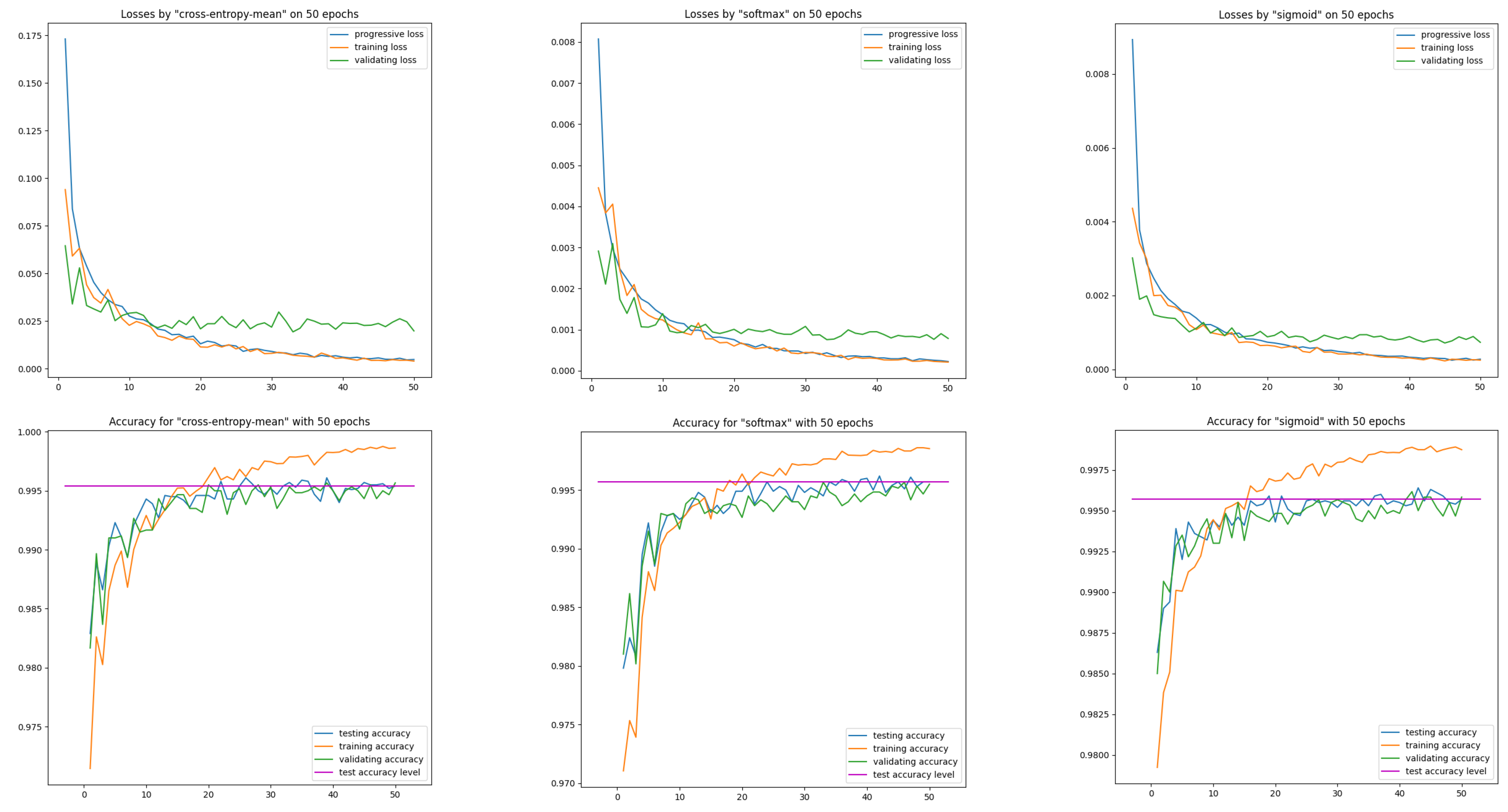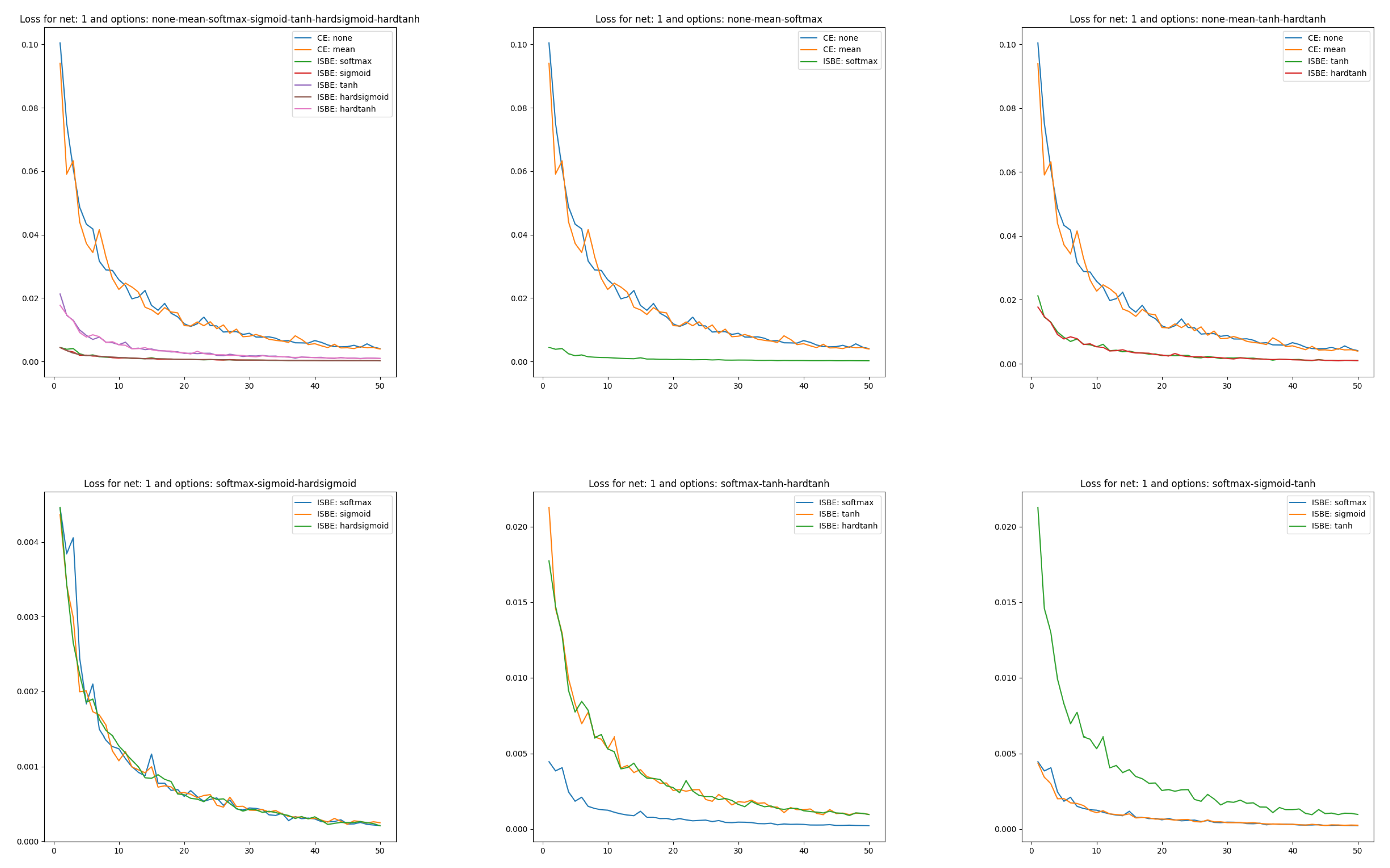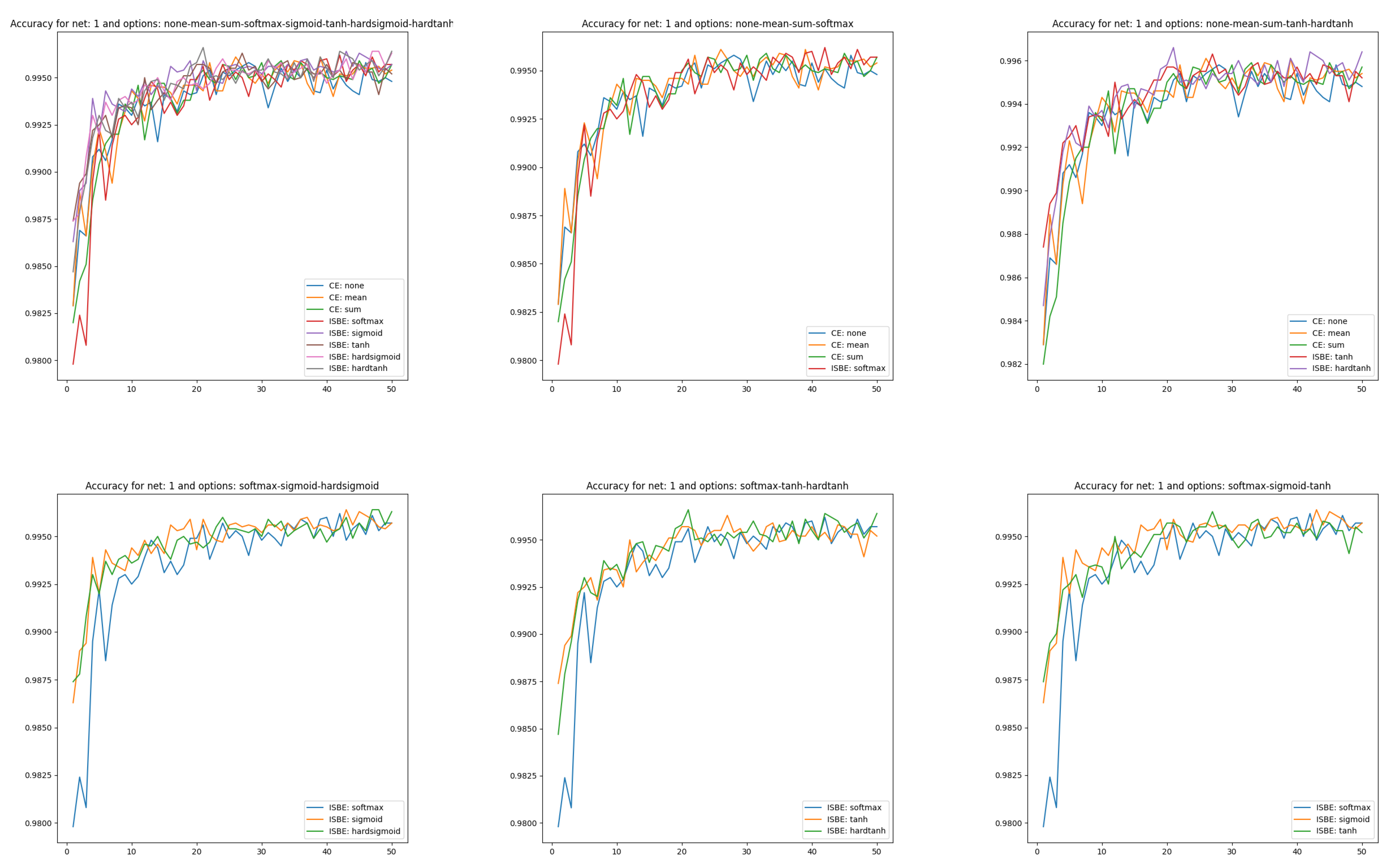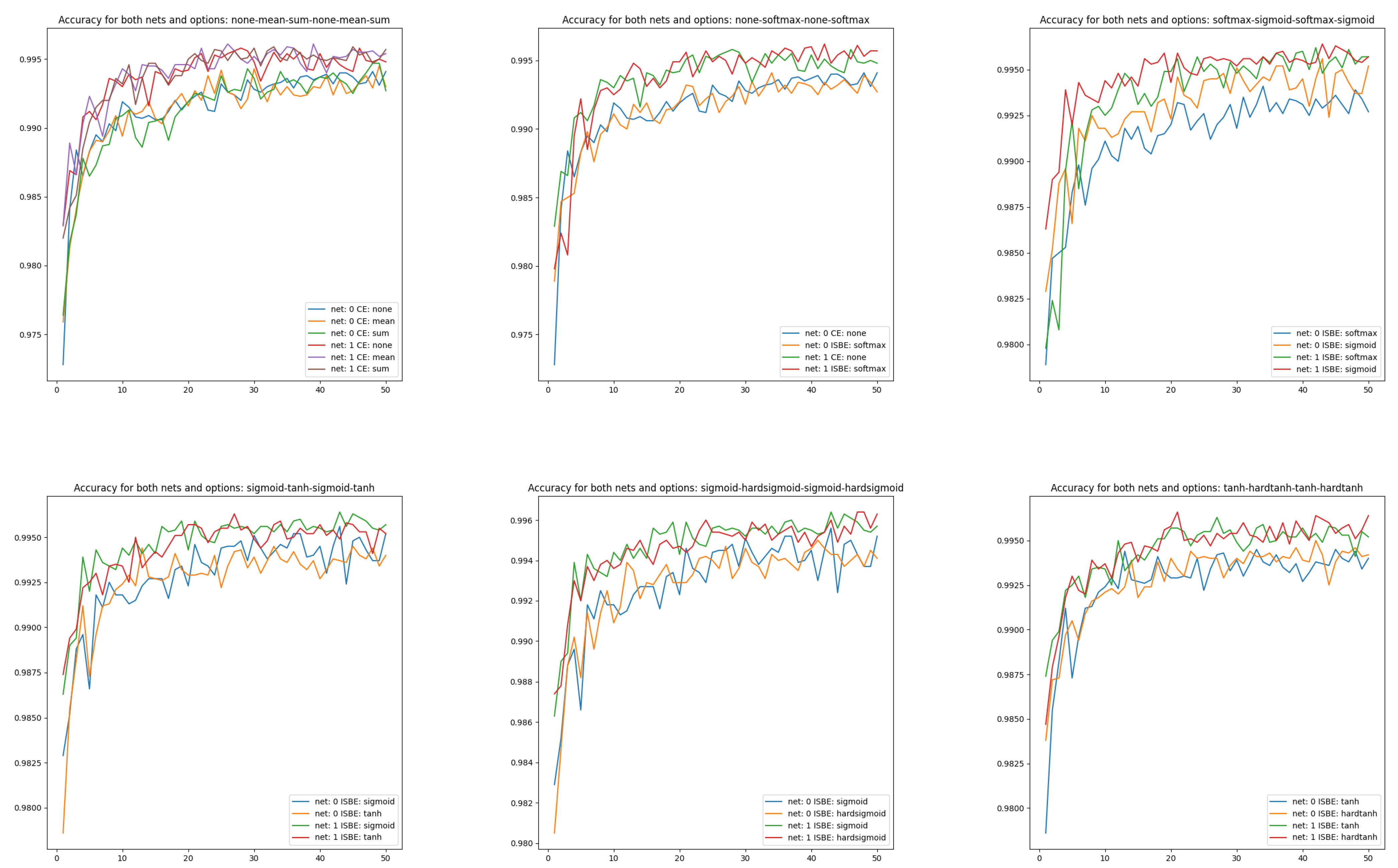Cross Entropy in Deep Learning of Classifiers Is Unnecessary—ISBE Error Is All You Need
Abstract
1. Introduction
- The second section is devoted to mathematics of the SoftMax trick. Its validity is proved in two ways:
- (a)
- Using gradient formulas for the composition of differentiable functions;
- (b)
- Using the concept of the Jacobian matrix and linear algebra calculus.
- In the third section titled ISBE Functionality, the conditions that a normalization unit must meet for its combination with a cross-entropy unit to have a gradient at the input equal to the difference in soft scores: are analyzed. Then the definition of ISBE functionality is introduced, which in the inference phase (I) normalizes the raw score to a soft score (S), and in the backward propagation phase (B) returns an error (E), equal to the difference in soft scores. It is also justified why, in the case of the normalization function, the ISBE functionality has, from the perspective of the learning process, the functionality of the integrated element CrossEntropy ∘ SoftMax.
- In the first subsection of the fourth section, using the example of the problem of recognizing handwritten digits and the standard MNIST(60K) image collection [25], numerous experiments show that in addition to the obvious savings in computational resources, in the case of five activations serving as normalization functions, the classifier’s effectiveness is not lower than that of the combination of the normalization SoftMax and Cross Entropy. This ISBE property was verified for the activation units SoftMax, Sigmoid, Hardsigmoid, and Tanh and Hardtanh. The second subsection of the fourth section reports on how ISBE behaves for a more demanding dataset CIFAR-10 and a more complex architecture VGG-16.
- The final fifth section contains conclusions.
- In Appendix A, the class of functions leading to the dilated SoftMax trick is fully characterized using concepts of dilation and relocation of function domain.
- In Appendix B the ISBE functionality is integrated with PyTorch class torch.autograd. Function.
- Introducing ISBE functionality as simplification and, at the same time, extension of the functional combination of SoftMax with CrossEntropy.
- Verification of ISBE feasibility and efficiency on two datasets and three CNN architectures.
- Enhancement of theoretical background for the concept of SoftMax trick via its generalization and full characterization of normalization functions which exhibit this property.
2. Discrete Cross-Entropy and the SoftMax Trick Property
- Using gradient formulas for the composition of differentiable functions,
- Using the concept of Jacobian matrix and linear algebra calculus.
- 1.
- For any .
- 2.
- 3.
- The range of covers the positive part of the real axis:
- 4.
- Let be the vector of raw scores, and be the target probability distribution. Then normalization followed by , is defined as followsContrary to only, exhibits the bounded gradient:
- (a)
- The Jacobian of equals to:
- (b)
- For any , where .
- (c)
- , where .
- (d)
- The range of covers the interval
3. ISBE Functionality
- In the inference phase (I), we normalize the raw score X to , characterized as a soft score (S).
- In the backward propagation phase (B), we return an error (E) equal to the difference between the calculated soft score and the target score, i.e., .
- The SoftMax activation function should be the first candidate for comparison, as it theoretically guarantees behavior comparable to the system containing cross-entropy.
- Activations should be monotonic so that the largest value of the raw score remains the largest score in the soft score sequence.
- Soft scores should be within a limited range, e.g., as in the case of SoftMax and Sigmoid, or as for Tanh.
- The activation function should not map two close scores to distant scores. For example, normalizing a vector of scores by projecting onto a unit sphere in the p-th Minkowski norm meets all the above conditions. However, it is not stable around zero. Normalization maps, for example, two points distant by to points distant exactly by 2, thus changing their distance times, e.g., a million times, when . This operation is known in Pytorch library as normalize function.
- example blurring value , e.g., :
- when the range of activation values is other than the interval , we adjust the vector to the new range, e.g., for tanh the range is the interval and then the adjustment has the form:
- This is what the code looks like when loss_function is chosen as nn.CrossEntropyLoss:for (labels,images) in tgen:outputs = net(images)loss = loss_function(outputs, labels)optimizer.zero_grad()loss.backward()optimizer.step()
- Now we introduce the ISBE option for SoftMax activation and replace the call for loss function by soft error calculation:for (labels,images) in tgen:outputs = net(images)soft_error = SoftMax(outputs) - labelsoptimizer.zero_grad()outputs.backward(soft_error)optimizer.step()
4. Experiments
4.1. Experiments with MNIST Dataset
- Two architecture options
- Architecture consists of two convolutions and two linear units , of which the last one is a projection from the space of deep feature vectors of dimension 512 to the space of raw scores for each of the classes:as by STNN notation [30], for instance
- Architecture consists of two blocks, each with three convolutions—it is a purely convolutional network, except for the final projection:Note that the last convolution in each block has a p requirement for padding, i.e., filling the domain of the image with additional lines and rows so that the image resolution does not change.
- Three options for reducing the vector of losses in the CrossEntropyLoss element: none, mean, sum.
- Five options for activation functions used in the ISBE technique:
- SoftMax:
- Tanh:
- HardTanh:
- Sigmoid:
- HardSigmoid:
4.1.1. Comparison of Time Complexity
4.1.2. Comparison of Classifier Accuracy
- of decrease time in the total time,
- simplification of architecture, and therefore playing the philosophical role of Occam’s razor.
4.1.3. Visual Analysis
- Curves of loss functions can appear together as long as the type of function is identical, which entails a similar range of variability for loss function values. One might wonder what measure of loss to adopt in the case of ISBE since this technique, in fact, does not calculate loss values. We opt for a natural choice of mean square error for errors in soft scores:where is the batch size.For such defined measures, it turns out that only the option of reduction by summing has a different range of variability, and therefore it is not on the Figure 2.
- In the case of classifier accuracy, a common percentage scale does not exclude placing all eight curves for each considered architecture. However, due to the low transparency of such a figure, it is also worth juxtaposing different groups of curves of the dependency . The accuracy of the classifier MNIST(60K) is calculated on the test set MNIST(10K).
- All options for loss functions (3) and soft score functions (5),
- CE none, CE mean, CE sum versus SoftMax,
- CE none, CE mean, CE sum versus tanh, hardtanh,
- SoftMax versus sigmoid, hardsigmoid,
- SoftMax versus tanh, hardtanh,
- SoftMax versus sigmoid, tanh.
- CrossEntropyLoss based with reduction option sum (as out of common range it was not shown),
- CrossEntropyLoss based with reduction options none, and mean,
- ISBE based with normalizations to range including functionsand ,
- ISBE based with normalizations to range including functions and .
- Comparison of CE versus soft options:
- all options for loss functions and soft score functions
- CE none, CE mean versus SoftMax,
- CE none, CE mean versus tanh, hardtanh.
- Comparison of SoftMax versus other soft options:
- SoftMax versus sigmoid, hardsigmoid,
- SoftMax versus tanh, hardtanh,
- SoftMax versus sigmoid, tanh.
- CE none, CE mean, CE sum from versus CE none, CE mean, CE sum from ,
- CE none, SoftMax from versus CE none, SoftMax from ,
- SoftMax, sigmoid from versus SoftMax, sigmoid from ,
- sigmoid, tanh from versus sigmoid, tanh from ,
- sigmoid, hardsigmoid from versus sigmoid, hardsigmoid from ,
- tanh, hardtanh from versus tanh, hardtanh from .
4.2. Experiments with CIFAR-10 Dataset

- In training, there are three groups of ISBE options: {hardtanh}, {tanh, hardsigmoid}, {sigmoid, SoftMax}.
- In testing there are two groups: {tanh, hardtanh} and {SoftMax, sigmoid, hardsigmoid}.
5. Conclusions
Funding
Data Availability Statement
Acknowledgments
Conflicts of Interest
Appendix A. Functions Giving the SoftMax Trick for Cross-Entropy
- 1.
- F is a generalized SoftMax function if there exist a reference point and a dilation vector , such that for every :where ⊙ operation is the component-wise multiplication.
- 2.
- F has a dilated SoftMax-type Jacobian, if there exists dilation vector , such that for every :where
- 3.
- F possesses the dilated SoftMax trick property, if for every target vector and its Jacobian matrix satisfies the following equation:
- Proof of implication :If the Jacobian of the function F is of the dilated SoftMax type, then for :
- Proof of implication : Denote the axis unit vector j by . Then . Substitute into property (A3) the target score vector . ThenTherefore . Swapping i with j we obtain: .Thus,
- Proof of implication :If , thenThe general formula is Therefore:Hence,
- Proof of implication :If and then the diagonal of the Jacobian matrix gives us differential Equations [32], from which we can determine the general form of the function ,Now we calculate the partial derivatives . If , thenFor , the result is the same:Therefore, for any , we have K equalities: , . This means that vector fields for each pair of functions and are identical.Integrating these fields yields the same function up to a constant : . Consequently, , , and therefore . From the unity condition, we can now determine the value of :
Appendix B. ISBE Functionality in PyTorch
Appendix B.1. Testing Soft Options-Direct Way
- The simplest way of replacing the call of the cross-entropy function is by calling and, after, subtracting target hot vectors or their soften versions, calling the backward for the net output:for (labels,images) in tgen:outputs = net(images)soft_error = SoftMax(outputs) - labelsoptimizer.zero_grad()outputs.backward(soft_error)optimizer.step()
- If we want to test more options and compare them with cross-entropy, the loop code will extend a bit:for (labels,images) in tgen:outputs = net(images)if no_cross_entropy:if soft_option=="SoftMax":soft_error = SoftMax(outputs) - labelsif soft_option=="tanh":soft_error = tanh(outputs) - (2.*labels-1.)elif soft_option=="hardtanh":soft_error = hardtanh(outputs) - (2.*labels-1.)elif # …# next optionsoptimizer.zero_grad()outputs.backward(soft_error)else:loss = loss_function(outputs, labels)optimizer.zero_grad()loss.backward()optimizer.step()
- If we prefer to have a visually shorter loop, then by introducing the variable soft_function and extending the class DataProvider with matching target labels for a given soft option, we finally obtain a compact form:for (labels,images) in tgen:outputs = net(images)if no_cross_entropy:soft_error = soft_function(outputs) - labelsoptimizer.zero_grad()outputs.backward(soft_error)else:loss = loss_function(outputs, labels)optimizer.zero_grad()loss.backward()optimizer.step()
- However, if we want to register ISBE functionality as torch.autograd.Function then we have to follow the instruction of PyTorch on this kind registration. The effect is described in the next subsection.
Appendix B.2. ISBE Functionality with Automatic Differentiation
- Body of forward:def forward(raw_scores, labels,options=dict(soft=’SoftMax’, num_classes=10, eps=1e-8)):K = options[’num_classes’]eps = options[’eps’]; soft_option = options[’soft’]one_hots = torch.nn.functional.one_hot(\labels, num_classes=K)*(1-K*eps)+eps)if soft_option==’SoftMax’:soft_scores = torch.nn.functional.SoftMax(raw_scores,dim=1)target_scores = one_hotselif soft_option==’sigmoid’:soft_scores = torch.nn.functional.sigmoid(raw_scores)target_scores = one_hotselif soft_option==’hardsigmoid’:soft_scores = torch.nn.functional.hardsigmoid(raw_scores)target_scores = one_hotselif soft_option==’tanh’:soft_scores = torch.nn.functional.tanh(raw_scores)target_scores = 2.*one_hots-1.elif soft_option==’hardtanh’:soft_scores = torch.nn.functional.hardtanh(raw_scores)target_scores = 2.*one_hots-1.soft_scores.requires_grad = Falsesoft_errors = soft_scores - target_scoresmse_soft = torch.mean(soft_errors**2)return mse_soft, soft_errors, soft_scores
- Body of setup_context:def setup_context(ctx, inputs, output):raw_scores, labels, options = inputsmse_soft, soft_errors, soft_scores = outputctx.set_materialize_grads(False)ctx.soft_errors = soft_errors
- Body of backward:def backward(ctx, grad_mse, grad_errors, grad_scores):return ctx.soft_errors, None, None
References
- Schmidhuber, J. Annotated History of Modern AI and Deep Learning. arXiv 2022, arXiv:2212.11279. [Google Scholar]
- Rosenblatt, F. The Perceptron: A Probabilistic Model For Information Storage and Organization in the Brain. Psychol. Rev. 1958, 65, 386–408. [Google Scholar] [CrossRef] [PubMed]
- Amari, S.I. A theory of adaptive pattern classifier. IEEE Trans. Electron. Comput. 1967, EC-16, 279–307. [Google Scholar] [CrossRef]
- Golden, R.M. Mathematical Methods for Neural Network Analysis and Design; The MIT Press: Cambridge, MA, USA, 1996. [Google Scholar]
- Fergus, P.; Chalmers, C. Applied Deep Learning—Tools, Techniques, and Implementation; Springer: Cham, Switzerland, 2022. [Google Scholar]
- Hinton, G. How to Represent Part-Whole Hierarchies in a Neural Network. Neural Comput. 2023, 35, 413–452. [Google Scholar] [CrossRef] [PubMed]
- MacKay, D.J.C. Information Theory, Inference, and Learning Algorithms; Cambridge University Press: Cambridge, UK, 2003. [Google Scholar]
- Kingma, D.P.; Ba, J. Adam: A Method for Stochastic Optimization. arXiv 2014, arXiv:1412.6980. [Google Scholar]
- Werbos, P.J. Applications of advances in: Nonlinear sensitivity analysis. In System Modeling and Optimization; Drenick, R., Kozin, F., Eds.; Springer: Berlin/Heidelberg, Germany, 1982. [Google Scholar]
- Rumelhart, D.E.; Hinton, G.E.; Williams, R.J. Learning Representations by Back-propagating Errors. In Neurocomputing: Foundations of Research; MIT Press: Cambridge, MA, USA, 1988. [Google Scholar]
- Paszke, A.; Gross, S.; Chintala, S.; Chanan, G.; Yang, E.; DeVito, Z.; Lin, Z.; Desmaison, A.; Antiga, L.; Lerer, A. Automatic differentiation in: PyTorch. In Proceedings of the 31st Conference on Neural Information Processing Systems NIPS, Long Beach, CA, USA, 4–9 December 2017. [Google Scholar]
- Lecun, Y.; Bottou, L.; Bengio, Y.; Haffner, P. Gradient-based learning applied to document recognition. Proc. IEEE 1998, 86, 2278–2324. [Google Scholar] [CrossRef]
- Sahin, H.M.; Miftahushudur, T.; Grieve, B.; Yin, H. Segmentation of weeds and crops using multispectral imaging and CRF-enhanced U-Net. Comput. Electron. Agric. 2023, 211, 107956. [Google Scholar] [CrossRef]
- Yan, G.; Jing, H.; Li, H.; Guo, H.; He, S. Enhancing Building Segmentation in Remote Sensing Images: Advanced Multi-Scale Boundary Refinement with MBR-HRNet. Remote Sens. 2023, 15, 3766. [Google Scholar] [CrossRef]
- Min, B.; Ross, H.; Sulem, E.; Veyseh, A.P.B.; Nguyen, T.H.; Sainz, O.; Agirre, E.; Heinz, I.; Roth, D. Recent Advances in Natural Language Processing via Large Pre-Trained Language Models: A Survey. arXiv 2021, arXiv:2111.01243. [Google Scholar] [CrossRef]
- Majumdar, S.; Ginsburg, B. MatchboxNet: 1D Time-Channel Separable Convolutional Neural Network Architecture for Speech Commands Recognition. arXiv 2020, arXiv:2004.08531v2. [Google Scholar]
- Chung, J.S.; Nagrani, A.; Zisserman, A. VoxCeleb2: Deep Speaker Recognition. arXiv 2018, arXiv:1806.05622. [Google Scholar]
- Han, J.; Landini, F.; Rohdin, J.; Diez, M.; Burget, L.; Cao, Y.; Lu, H.; Cernocky, J. DiaCorrect: Error Correction Back-end For Speaker Diarization. arXiv 2023, arXiv:2309.08377. [Google Scholar]
- Chang, X.; Skarbek, W. Multi-Modal Residual Perceptron Network for Audio-Video Emotion Recognition. Sensors 2021, 21, 5452. [Google Scholar] [CrossRef]
- Reis, D.; Kupec, J.; Hong, J.; Daoudi, A. Real-Time Flying Object Detection with YOLOv8. arXiv 2023, arXiv:2305.09972. [Google Scholar]
- Bridle, J.S. Probabilistic Interpretation of Feedforward Classification Network Outputs, with Relationships to Statistical Pattern Recognition; Soulié, F.F., Hérault, J., Eds.; Neurocomputing. NATO ASI Series; Springer: Berlin/Heidelberg, Germany, 1990; Volume 68, pp. 227–236. [Google Scholar]
- Bishop, C.M. Pattern Recognition and Machine Learning; Springer: Berlin/Heidelberg, Germany, 2006. [Google Scholar]
- Mohri, M.; Rostazadeh, A.; Talwalkar, A. Foundations of Machine Learning; The MIT Press: Cambridge, MA, USA, 2012. [Google Scholar]
- Cho, J.H.; Hariharan, B. On the Efficacy of Knowledge Distillation. arXiv 2019, arXiv:1910.01348. [Google Scholar]
- LeCun, Y.; Cortes, C.; Burges, C.J.C. THE MNIST DATABASE of Handwritten Digits. 1998. Available online: http://yann.lecun.com/exdb/mnist/ (accessed on 11 November 2013).
- Bendersky, E. The SoftMax Function and Its Derivative. Available online: https://eli.thegreenplace.net/2016/the-softmax-function-and-its-derivative/ (accessed on 11 November 2013).
- Golub, G.H.; Van Loan, C.F. Matrix Computations, 3rd ed.; Johns Hopkins University Press: Baltimore, MD, USA, 1996. [Google Scholar]
- Liu, S.; Leiva, V.; Zhuang, D.; Ma, T.; Figueroa-Zúñiga, J.I. Matrix differential calculus with applications in the multivariate linear model and its diagnostics. J. Multivar. Anal. 2022, 188, 104849. [Google Scholar] [CrossRef]
- Gao, B.; Lacra, P. On the Properties of the SoftMax Function with Application in Game Theory and Reinforcement Learning. arXiv 2018, arXiv:1704.00805. [Google Scholar]
- Skarbek, W. Symbolic Tensor Neural Networks for Digital Media—From Tensor Processing via BNF Graph Rules to CREAMS Applications. Fundam. Inform. 2019, 168, 89–184. [Google Scholar] [CrossRef]
- Simonyan, K.; Zisserman, A. Very Deep Convolutional Networks for Large-Scale Image Recognition. arXiv 2014, arXiv:1409.1556. [Google Scholar]
- Riley, K.F.; Hobson, M.P.; Bence, S.J. Mathematical Methods for Physics and Engineering; Cambridge University Press: Cambridge, UK, 2010. [Google Scholar]








| Net | Mean | None | Sum | Hsigmoid | Htanh | Sigmoid | SoftMax | Tanh |
|---|---|---|---|---|---|---|---|---|
| 60.61% | 59.56% | 59.98% | 58.31% | 58.21% | 57.38% | 57.45% | 59.07% | |
| 54.89% | 53.92% | 53.98% | 52.68% | 52.33% | 51.75% | 51.95% | 52.11% | |
| 54.45% | 53.92% | 54.00% | 52.78% | 52.30% | 51.67% | 51.73% | 52.11% |
| Net | CE Loss | Hsigmoid | Htanh | Sigmoid | SoftMax | Tanh |
|---|---|---|---|---|---|---|
| mean | −2.30% | −2.40% | −3.23% | −3.16% | −1.54% | |
| none | −1.25% | −1.35% | −2.18% | −2.11% | −0.50% | |
| sum | −1.67% | −1.77% | −2.60% | −2.53% | −0.92% | |
| mean | −2.21% | −2.56% | −3.14% | −2.94% | −2.79% | |
| none | −1.24% | −1.59% | −2.17% | −1.97% | −1.82% | |
| sum | −1.30% | −1.65% | −2.23% | −2.03% | −1.87% |
| Net | Mean | None | Sum | Hsigmoid | Htanh | Sigmoid | SoftMax | Tanh |
|---|---|---|---|---|---|---|---|---|
| 99.45% | 99.41% | 99.47% | 99.50% | 99.50% | 99.56% | 99.41% | 99.45% | |
| 99.61% | 99.58% | 99.59% | 99.64% | 99.66% | 99.64% | 99.62% | 99.63% | |
| 99.55% | 99.64% | 99.64% | 99.61% | 99.66% | 99.69% | 99.63% | 99.57% |
| Net | CE Loss | Hsigmoid | Htanh | Sigmoid | SoftMax | Tanh |
|---|---|---|---|---|---|---|
| mean | 0.05% | 0.05% | 0.11% | −0.04% | 0.00% | |
| none | 0.09% | 0.09% | 0.15% | 0.00% | 0.00% | |
| sum | 0.13% | 0.03% | 0.09% | −0.06% | −0.02% | |
| mean | 0.03% | 0.05% | 0.03% | 0.01% | 0.02% | |
| none | 0.06% | 0.08% | 0.06% | 0.04% | 0.05% | |
| sum | 0.05% | 0.07% | 0.05% | 0.03% | 0.04% |
Disclaimer/Publisher’s Note: The statements, opinions and data contained in all publications are solely those of the individual author(s) and contributor(s) and not of MDPI and/or the editor(s). MDPI and/or the editor(s) disclaim responsibility for any injury to people or property resulting from any ideas, methods, instructions or products referred to in the content. |
© 2024 by the author. Licensee MDPI, Basel, Switzerland. This article is an open access article distributed under the terms and conditions of the Creative Commons Attribution (CC BY) license (https://creativecommons.org/licenses/by/4.0/).
Share and Cite
Skarbek, W. Cross Entropy in Deep Learning of Classifiers Is Unnecessary—ISBE Error Is All You Need. Entropy 2024, 26, 65. https://doi.org/10.3390/e26010065
Skarbek W. Cross Entropy in Deep Learning of Classifiers Is Unnecessary—ISBE Error Is All You Need. Entropy. 2024; 26(1):65. https://doi.org/10.3390/e26010065
Chicago/Turabian StyleSkarbek, Władysław. 2024. "Cross Entropy in Deep Learning of Classifiers Is Unnecessary—ISBE Error Is All You Need" Entropy 26, no. 1: 65. https://doi.org/10.3390/e26010065
APA StyleSkarbek, W. (2024). Cross Entropy in Deep Learning of Classifiers Is Unnecessary—ISBE Error Is All You Need. Entropy, 26(1), 65. https://doi.org/10.3390/e26010065





